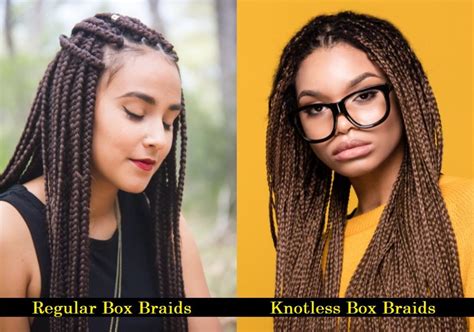As a trendy and versatile protective hairstyle, both knotless braids and box braids have gained immense popularity. While they share some similarities, these two braiding techniques differ significantly in terms of application, appearance, and maintenance.

Knotless Braids
Knotless braids, also known as invisible braids or feed-in braids, are created without using any knots to attach the hair extensions. Instead, the braider gradually feeds the natural hair into the braid, resulting in a seamless and natural-looking style.
Pros:
- Less tension on the scalp: Knotless braids distribute weight more evenly, reducing tension and minimizing scalp irritation.
- Longer-lasting: By eliminating knots, knotless braids are less prone to breakage and can last up to 8 weeks.
- Versatile: Knotless braids can be styled in various ways, including buns, ponytails, and braids.
- Comfortable to wear: The absence of knots makes knotless braids lightweight and comfortable to wear for extended periods.
Cons:
- Time-consuming: Knotless braids require more time to install than other braiding methods.
- Can be expensive: The intricate installation process increases the cost of knotless braids.
- May not be suitable for all hair types: Knotless braids may not be the best option for those with very fine or damaged hair.
Box Braids
Box braids, also known as square braids, are formed by sectioning the hair into small squares and then braiding each section individually. Extensions are added to the hair as the braid progresses.
Pros:
- Quick and convenient: Box braids are relatively quick and easy to install.
- Long-lasting: Proper installation ensures box braids can last up to 12 weeks.
- Versatile: Box braids come in various sizes and colors, allowing for customization.
- Great for protective styling: Box braids effectively protect natural hair from damage.
Cons:
- Can be heavy: The weight of extensions and the bulky nature of box braids can put strain on the scalp.
- Higher risk of breakage: Box braids can cause breakage if not installed or maintained properly.
- May be difficult to wash: Washing box braids can be challenging and time-consuming.
- Limited styling options: Box braids are less versatile in terms of styling compared to knotless braids.
Comparison of Key Features
| Feature | Knotless Braids | Box Braids |
|---|---|---|
| Tension on Scalp | Less | More |
| Lifespan | 6-8 Weeks | 8-12 Weeks |
| Installation Time | Longer | Shorter |
| Cost | More Expensive | Less Expensive |
| Versatility | More Versatile | Less Versatile |
Making an Informed Decision
Choosing between knotless braids and box braids depends on your individual preferences, hair type, and lifestyle.
Consider Knotless Braids if:
- You want to minimize scalp tension.
- You have fine or fragile hair.
- You want a style that is versatile and comfortable.
Consider Box Braids if:
- You want a quick and convenient installation.
- You prefer long-lasting braids.
- You are not concerned about scalp tension or breakage.
Conclusion
Both knotless braids and box braids offer unique advantages and disadvantages. By understanding the differences between these two braiding techniques, you can make an informed decision based on your specific needs and hair type. Remember to consult with a professional hair stylist for personalized advice and proper installation to ensure healthy and beautiful braids.
